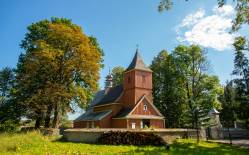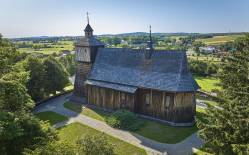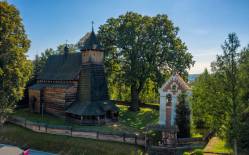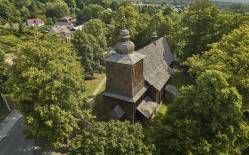The first church in Szebnie was built in 1326. It was followed by four other churches, all destroyed by fire. The present church was erected in 1605. In 1894 it was significantly reconstructed; the bell tower, posing a risk of caving in, was demolished; the nave was prolonged, and annexes were added along the sides of the nave and the chancel. A new brick belfry was also built.
The log tripartite building is not oriented eastward. The chancel enclosed with semi-hexagonal walls on the eastern side is adjoined by the sacristy and on the western by a brick treasury. The nave, with a narrower section added in 1894, is adjoined on the northern side by a porch and on the western side by two porches connected with a small side roof supported by pillars. The building is covered with a gable roof, topped with a bell turret.
Inside we can see flat coved ceilings. The walls and ceilings are embellished with figural and ornamental paintings. The 18th century furnishings include three altars – the high altar with a picture of St. Martin and figure of Christ on the Cross, the left-side altar with a representation of the Holy Family, and the right-side altar with a painting of the Heart of Jesus. Below the choir gallery we can see the holy water font made from a single stone.
In 1943 new painted decorations in a style of folk art were contributed by Prof. Jan Wodyński. In 1957 new polychrome paintings were added. New pipe organs, manufactured by the Czech company Rieger, and originally located in the Jesuit church in Tarnopol, were installed in the church.
Since the new church was built in 2003, the old one has no longer been used for religious ceremonies.
Next to the church we can see a brick belfry from the late 1800s and classicist tombstones of the Gorajski family.
During WWII, a forced labour camp and a detention area was maintained in Szebnie by the Nazis, from October 1941 operating as a concentration camp. In spring of 1942 a camp designated for Soviet prisoners of war was established; approximately 4000 people perished there. The famous poem by Wisława Szymborska entitled Starvation Camp near Jasło was inspired by the camp in Szebnie.
Photo: Krystian Kłysewicz
Gallery
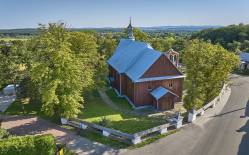
Recommended venues on the Trail



This website has been modernized with the financial support of the European Union under the Cross-Border Cooperation Programme Poland-Belarus-Ukraine 2014-2020. The responsibility for its content lies solely with the Podkarpackie Regional Tourism Board and cannot, in any case, be treated as a reflection of the position of the European Union, the Managing Authority, or the Joint Technical Secretariat of the Cross-Border Cooperation Programme Poland-Belarus-Ukraine 2014-2020.










